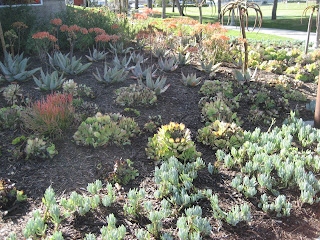Water Thrifty Plants
Rebate Central for Southern California
What's Wrong With My Photenia's?
 |
Entomosporium Leaf Spot on Red Tip
Leaf spot, caused by the fungus Entomosporium maculatum, is a widespread and destructive disease of red tip (Photinia fraseri), loquat (Eriobotrya japonica), India hawthorn (Rhaphiolepis indica), some pear cultivars (Pyrussp.) and several other members of the rose family. This disease is most damaging to plants in the landscape and nurseries during periods of cool, wet weather and when active growth is occurring.
 Entomosporium leaf spot on red tip. |
Low levels of leaf spot usually cause little more than cosmetic damage but maintain a source of spores for future infections. Severe infections, however, often result in early and heavy leaf drop. Heavy leaf drop severely reduces the landscape value of red tip and can cause plant death. Some cultivars of India hawthorn are as severely affected as red tip.
Spots on the leaves and young shoots are important in the survival of the Entomosporium leaf spot fungus. Fallen, diseases leaves are less important sources of the fungus. Masses of spores are released during periods of wet weather from the fungal spore producing structures in the center of the spots from late winter through much of the year except during the hot periods of summer. These spores are spread to healthy foliage by a combination of splashing water and wind. New leaf spot symptoms appear within 10-14 days after a wet infection period.
For the landscape, purchase plants showing no leaf spot symptoms. Isolated healthy plants or hedges can often remain healthy as the spores are only splashed over short distances. Space plants to improve the air movement around the plants and promote rapid drying of leaf surfaces. If it is necessary to irrigate the plants, do not wet the foliage or irrigate in midday to reduce the period of time foliage remains wet. If possible, remove fallen diseased leaves. Do not water or fertilize plants any more than necessary to avoid promoting excess new growth. Also, reduce pruning during the summer which promotes continual new growth. Severely defoliated plants may need to be pruned heavily to have a small, easier to spray plant, to reduce the source of spores and improve air movement. It may be necessary to remove severely diseased plants that have also been damaged by cold injury and replace them with another plant species that is not susceptible to leaf spot.
Several fungicides may also be help in the management of leaf spot in the landscape.
Reasearch provided by Ornamental Disease Information Note 11
Ronald K. Jones, Plant Pathologist (retired)Mike Benson, Plant Pathologist
For more help on identifying plant problems call Monarch.


















